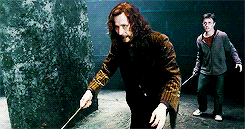For an overview of the project, see here
Check for Surprise
Before an encounter begins (and if the fictional circumstances have not already accounted for it) check for Surprise. Each monster has an X-in-6 chance in its description.
If you are surprised, the monsters get a free action. Because you cannot respond to these actions you must make Luck rolls to avoid them.
If you surprise the monsters, you get a free action. You must still roll, but the monsters cannot respond this turn.
Combat Structure
- Referee hints at NPC actions
Players declare actions
Resolve actions
Resolving Actions in Combat
Actions taken against an opponent use that opponent’s relevant stat for the Difficulty.
The procedure is essentially the same whether the player is initiating an action or reaction to an NPC. In either case, the loser of the exchange suffers damage (or whatever other effect their opponent was trying to impose). You can use any Skill in combat as long as you can justify your actions within the fiction. Some actions might not work - for example, trying to block a giant's club with your shield - and will automatically fail. Most of the time, however, your choice of Skill will simply suggest the kind of effect that you can achieve.
Damage, Injury & Death
Whenever you take damage you must make a Strength test using your newly reduced score.
If you succeed, all’s well. If you fail, you have taken an Injury. Roll for location and severity. While Injured, any rolls that your Injury might reasonably apply to become Deadly.
If you are Injured twice in the same location you begin Dying.
Location – roll d6
1: Left Leg
2: Right Leg
3: Left Arm
4: Right Arm
5: Torso
6: Head
Severity – roll d6
1: Grievous – you are now Dying.
2-5: Severe – your injury clears at the end of your next Town phase.
6: Minor – your injury clears after your next Rest.
Dying
Each turn, roll 1d6. On a 1, you die. If you exert yourself in a given round (fighting, moving quickly, casting a spell, etc) you die on a 1-2 instead.
If you survive an injury that left you Dying you gain a Scar (this can be an actual scar, a limp, a missing eye or digit, etc). The player describes the Scar.
Scars
Mechanically, Scars work like Flaws, in that you can invoke them in a relevant situation to increase a roll’s level of Danger and gain Inspiration. Additionally, the GM can invoke a Scar in situations where it would be relevant (for example, trying to tie a knot with a missing hand). This makes a roll Deadly but does not grant Inspiration.
Healing
A successful Herbology or Potions roll reduces an Injury’s severity by one stage:
Dying → Severe → Minor
Minor Injuries cannot be cured by magic – you must Rest to fully recover.
Safe & Deadly Combat Rolls
If no other ruling for a mixed result on a combat roll seems more relevant, consider one of the following:
The attack succeeds, but deals -2 damage (min. 0)
The attack succeeds, but the attacker takes damage in return.
Design Notes: this is my first experiment with a looser "problem solving" combat system. The flexibility of "everybody is a wizard" suggested an open-ended approach to combat where most skills can be used in a fight as long as you can justify it within the fiction. As we'll see later in the Skills section, straightforward combat options exist in Fighting (for mundane weapons) and Curses (offensive spells), but the system supports using Charms to levitate your opponent's club, Transfiguration to animate a statue to intercept a blow, Divination to predict an enemy's spell and counter it in the nick of time, etc.




No comments:
Post a Comment